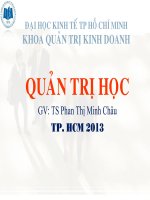Bài giảng môn Quản trị học Chương 6
Bạn đang xem bản rút gọn của tài liệu. Xem và tải ngay bản đầy đủ của tài liệu tại đây (1010.51 KB, 33 trang )
6
Chapter
Organizationa
l Structure
and Design
© Pearson Education Limited 2015
6-1
Learning Outcomes
• Describe six key elements in organizational
design.
• Identify the contingency factors that favor either
the mechanistic model or the organic model of
organizational design.
• Compare and contrast traditional and
contemporary organizational designs.
• Discuss the design challenges faced by today’s
organizations.
© Pearson Education Limited 2015
6-2
6.1 Describe six key
elements in
organizational
design.
© Pearson Education Limited 2015
6-3
Elements of Organizational
Structure
•
•
•
•
•
•
Work specialization
Departmentalization
Authority and responsibility
Span of control
Centralization vs. decentralization
Formalization
© Pearson Education Limited 2015
6-4
Specialization
© Pearson Education Limited 2015
6-5
Departmentalization
© Pearson Education Limited 2015
6-6
Types of Authority Relationships
© Pearson Education Limited 2015
6-7
Line and Staff Authority
© Pearson Education Limited 2015
6-8
Unity of Command
A structure in which each employee reports to
only one manager.
© Pearson Education Limited 2015
6-9
How Do Authority and Power
Differ?
Authority:
Power:
a right whose legitimacy an individual’s ability to
is based on an authority influence decisions
figure’s position in the
organization; it goes
with the job
© Pearson Education Limited 2015
6-10
Power Versus Authority
© Pearson Education Limited 2015
6-11
Sources of Power
© Pearson Education Limited 2015
6-12
Span of Control
Most effective and efficient span depends on:
• Employee experience and training (more they
have, larger span).
• Similarity of employee tasks (more similarity,
larger span).
• Complexity of those tasks (more complex,
smaller span).
© Pearson Education Limited 2015
6-13
Centralization & Decentralization
Centralization
decision making takes
place at upper levels of
the organization
Decentralization
lower-level managers
provide input or actually
make decisions
© Pearson Education Limited 2015
6-14
Formalization
How standardized an organization’s jobs are and
the extent to which employee behavior is guided
by rules and procedures.
© Pearson Education Limited 2015
6-15
6.2 Identify the contingency
factors that favor either
the mechanistic model
or the organic model of
organizational design.
© Pearson Education Limited 2015
6-16
Models of Organizational Design
© Pearson Education Limited 2015
6-17
Strategy and Structure
Certain structural designs work best with
different organizational strategies.
© Pearson Education Limited 2015
6-18
Size and Structure
Organic
Less than 2,000
employees can be
organic.
Mechanistic
More than 2,000
employees makes forces
organizations to become
more mechanistic.
© Pearson Education Limited 2015
6-19
Technology and Structure
© Pearson Education Limited 2015
6-20
Environment and Structure
Stable environment: mechanistic structure
Dynamic environment: organic structure
© Pearson Education Limited 2015
6-21
6.3 Compare and
contrast traditional
and contemporary
organizational
designs.
© Pearson Education Limited 2015
6-22
Traditional Organizational Designs
© Pearson Education Limited 2015
6-23
Contemporary Organizational
Design
© Pearson Education Limited 2015
6-26
Team Structure
A structure in which the entire organization is
made up of work teams that do the
organization’s work.
© Pearson Education Limited 2015
6-27









